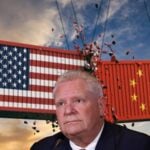The cross-border Great Lakes economy enters the fourth quarter with a bullseye on its back.
The region’s tightly linked manufacturing and services base supports 55 million jobs, according to new research from BMO Economics, and accounts for roughly 30% of combined Canadian and U.S. employment and economic output.
That scale made the corridor from Ontario and Quebec through Michigan, Ohio, Illinois, New York, Pennsylvania, Wisconsin, Minnesota, and Indiana a post-pandemic anchor.
It also makes it highly exposed when tariff policy shifts without warning.
Investors and executives are recalibrating after the White House said imports of medium and heavy trucks will face a 25% tariff starting Nov. 1.
The new duty lands on top of a broader mix of tariffs that has already complicated pricing and sourcing decisions for automakers, parts suppliers, metals producers, and shippers on both sides of the border.
The policy fog is arriving ahead of the scheduled 2026 review of the United States-Mexico-Canada Agreement, which many regional companies had hoped would lock in a stable rulebook for the next decade.
The Great Lakes economy is built on just-in-time manufacturing, dense supply chains, and efficient crossings. Auto parts can cross the Detroit-Windsor span multiple times before a vehicle rolls off the line.
That choreography works when costs and customs treatment are predictable. When tariffs change, even for a subset of products, firms hedge with extra inventory, rework logistics, or push back hiring and capital expenditures.
Margins thin, production schedules slip, and some activity migrates to lower-friction jurisdictions.
State leaders are pressing Washington to narrow the scope and duration of duties that hit North American partners. In a keynote address in Toronto last week, Michigan Gov.
Gretchen Whitmer said the tariffs are already weighing on production plans and worker paychecks. “We must keep talking and keep showing up for each other. We will get through this together,” Whitmer said in a press release.
She warned that a pullback in trilateral trade would trigger “massive job losses” and disrupt critical supply lines for fuel, parts, and produce.
Canadian Prime Minister Mark Carney visits the White House today for talks that are expected to focus on tariff exposure for autos and industrial inputs, and on ways to preserve the benefits of the USMCA.
The stakes are unusually high in the Great Lakes, where integrated industries have spent three decades knitting together shared production platforms and regional talent pools.
Business groups in both countries argue that the region’s competitiveness depends on minimizing policy volatility even while confronting unfair trade by non-USMCA producers.
The BMO report underscores that the Great Lakes economy has diversified far beyond factories, with large shares of employment in health care, trade, and professional services. That breadth is a cushion, but not a shield.
Manufacturing remains a critical linchpin for regional wages and export earnings, and it amplifies transport, engineering, and logistics activity across the corridor.
When tariffs choke the movement of parts or raise input costs, that ripple shows up in payrolls from Cleveland to Kitchener to Green Bay.
The Gordie Howe International Bridge, slated to open soon, promises more capacity and quicker customs processing at North America’s most important commercial crossing.
Continued investment in port infrastructure along the St. Lawrence and Great Lakes can trim transit times and diversify routes.
Those improvements will matter more if policymakers reduce North American-on-North American tariff friction and set clearer rules for content and critical minerals in emerging vehicle platforms.
For now, companies tied to the Great Lakes should plan for a longer period of policy noise, keep contingency playbooks ready, and advocate for targeted carve-outs that recognize how integrated the region has become.
The number that matters most is still the same: 55 million workers depend on a system that functions best when it is open, efficient, and predictable.


















